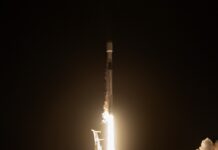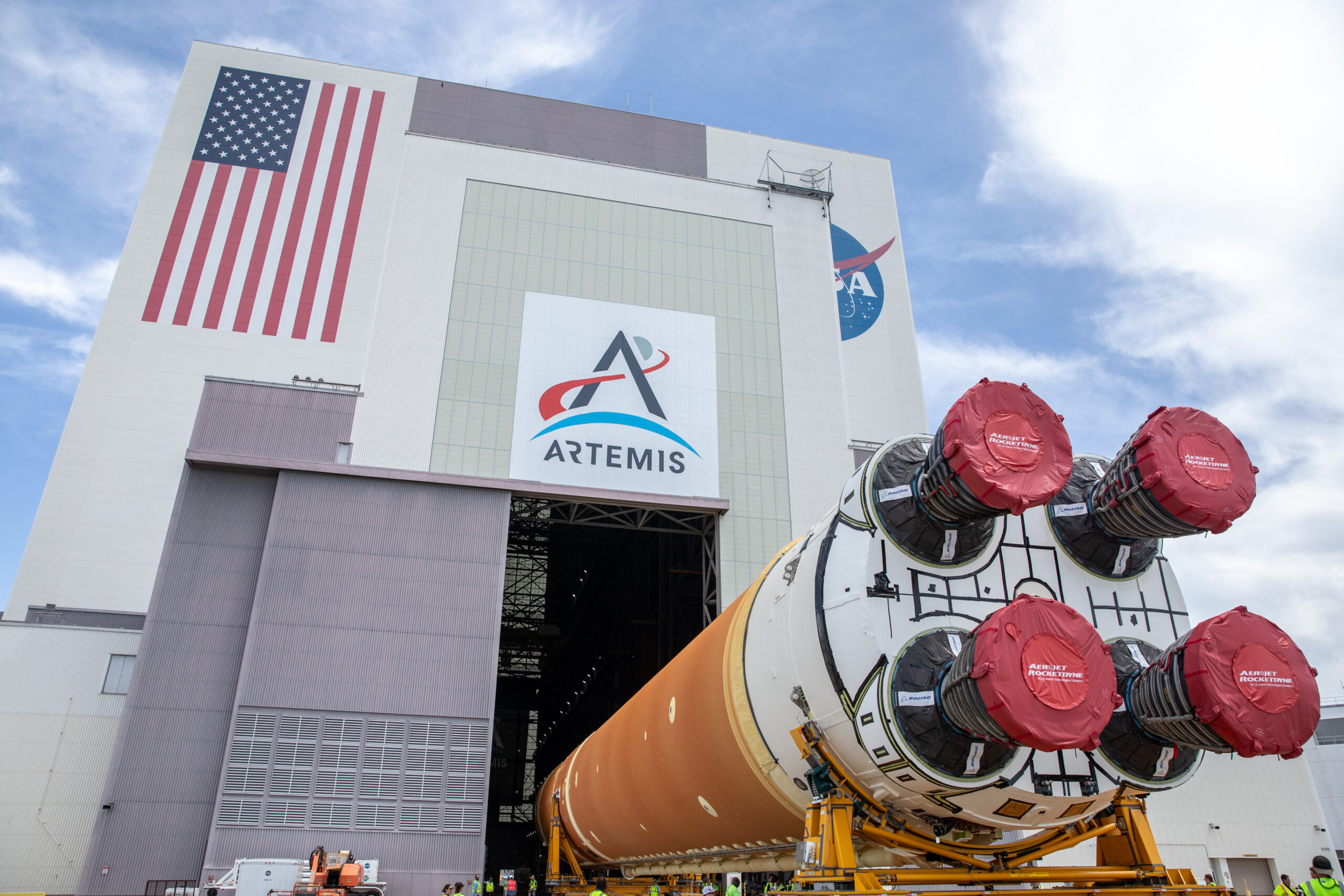NASA’s SLS Rocket Core Stage Arrives at Kennedy Space Center for Artemis II Mission
NASA’s Space Launch System (SLS) rocket core stage for the Artemis II mission has successfully arrived at the Vehicle Assembly Building (VAB) at Kennedy Space Center in Florida. This milestone is a significant step towards NASA’s ambitious Artemis program, which aims to return humans to the Moon and eventually pave the way for future Mars missions.
The core stage, an integral part of the SLS rocket, was transported over a distance of 900 miles from NASA’s Michoud Assembly Facility in New Orleans to the Florida spaceport. The journey involved tugboats and towing vessels maneuvering the barge carrying the core stage. This logistical feat was executed with precision by NASA’s Exploration Ground Systems Program team, ensuring the safe transfer of the 212-foot-tall core stage.
Upon arrival at Kennedy Space Center on July 23, the core stage was carefully moved from NASA’s Pegasus barge to a self-propelled module transporter. This transporter is specifically designed to handle large hardware elements. The core stage was then rolled into the VAB transfer aisle, where it will undergo further processing in preparation for rocket stacking operations.
In the upcoming months, the core stage will be integrated with additional Artemis II flight hardware atop the mobile launcher. This includes the twin solid rocket boosters, the launch vehicle stage adapter, and the Orion spacecraft. The Artemis II mission is poised to be NASA’s first crewed mission under the Artemis program, featuring NASA astronauts Victor Glover, Christina Koch, Reid Wiseman, and Canadian Space Agency astronaut Jeremy Hansen. The mission will involve a 10-day journey around the Moon and back, marking a significant milestone in human space exploration.
Insights from Chris Calfee’s 38-Year Career at NASA
Chris Calfee, a veteran at NASA’s Marshall Space Flight Center, has had a remarkable 38-year career filled with numerous highlights. One of his most cherished memories is witnessing the launch of the Artemis I mission from Kennedy Space Center in 2022. Calfee has played a pivotal role in several high-profile projects, including the Chandra X-Ray Observatory, the Demonstration of Autonomous Rendezvous Technology (DART), and the Ares I-X test flight.
As the SLS Spacecraft Payload Integration and Evolution (SPIE) element manager, Calfee is responsible for overseeing the development and delivery of key adapter hardware for the SLS rockets. This hardware includes the launch vehicle stage adapter, interim cryogenic propulsion stage, and the Orion stage adapter. The SPIE Element Office is essential for the successful execution of the SLS mission, both in its initial launch capability and the evolution of subsequent rocket configurations.
Reflecting on the shipment of the SLS core stage for Artemis II, Calfee expressed his excitement and pride. "Seeing the Chandra mission fly and the success it has had is awesome. Being able to work DART from cradle to grave, including its flight, was unforgettable. But I’d have to say being able to represent the SLS SPIE Element Office at Kennedy’s Launch Control Center and seeing Artemis I light up the night sky is the proudest moment."
Thomas Brown’s New Role at NASA’s Marshall Space Flight Center
Thomas Brown has been appointed as the center chief engineer and manager of the Chief Engineering Office within the Engineering Directorate at NASA’s Marshall Space Flight Center, effective July 28. In this role, Brown will ensure the technical excellence and success of all Marshall-assigned spacecraft, propulsion, science payload, life support, and mission systems.
Brown’s responsibilities include providing expert technical leadership in planning, directing, and executing research, technology development, ground and flight systems design, production, integration, and sustaining engineering for various NASA programs. Before this appointment, Brown served as the director of the Propulsion Systems Department, managing a $68 million annual budget and overseeing a workforce responsible for propulsion components and systems at Marshall and other NASA centers.
Brown’s extensive career at NASA began in 1999 as an aerospace engineer. Over the years, he has contributed to numerous propulsion technology development efforts and held several leadership positions. Brown holds a bachelor’s degree in physics from Allegheny College and master’s and doctoral degrees in mechanical engineering from Vanderbilt University. He has published over 30 journal publications and holds a U.S. patent related to propulsion technology.
Orbital Reef’s Milestone in Low Earth Orbit Development
An element of the NASA-funded commercial space station, Orbital Reef, under development by Blue Origin and Sierra Space, recently completed a full-scale ultimate burst pressure test. This milestone is part of NASA’s efforts to develop new destinations in low Earth orbit.
The burst test was conducted on Sierra Space’s LIFE (Large Integrated Flexible Environment) habitat structure using testing capabilities at NASA’s Marshall Space Flight Center. The inflatable habitat is made from high-strength webbings and fabric, forming a solid structure once pressurized. The successful test demonstrated the habitat’s capabilities and provided critical data supporting NASA’s inflatable softgoods certification guidelines.
Angela Hart, manager of NASA’s Commercial Low Earth Orbit Development Program, expressed her excitement about the test. "This is an exciting test by Sierra Space for Orbital Reef, showing industry’s commitment and capability to develop innovative technologies and solutions for future commercial destinations."
New Insights from NASA’s DART Mission
NASA’s Double Asteroid Redirection Test (DART) mission, which intentionally collided with the asteroid moonlet Dimorphos in 2022, has provided new information on the origins of the target binary asteroid system. The mission’s science team recently published five papers in Nature Communications, exploring the geology of the binary asteroid system comprising moonlet Dimorphos and parent asteroid Didymos.
The findings offer new insights into the ways asteroids can change over time, contributing to our understanding of near-Earth objects and the history of our Solar System. The analysis suggested that both Didymos and Dimorphos have weak surface characteristics, with Dimorphos likely forming from material shed by Didymos in a large mass shedding event.
Olivier Barnouin and Ronald-Louis Ballouz of Johns Hopkins Applied Physics Laboratory led a paper analyzing the geology of both asteroids. "The images and data that DART collected at the Didymos system provided a unique opportunity for a close-up geological look of a near-Earth asteroid binary system," said Barnouin.
NASA’s Fermi Gamma-ray Space Telescope Discovers New Feature in GRB
In October 2022, NASA’s Fermi Gamma-ray Space Telescope recorded the brightest gamma-ray burst (GRB) ever observed, dubbed the brightest-of-all-time (BOAT). An international science team has since discovered a feature never seen before in 50 years of studying GRBs.
The unusual energy peak, detected a few minutes after the BOAT erupted, is believed to be the first high-confidence emission line observed in a GRB. The team thinks the most likely source of this spectral feature is the annihilation of electrons and positrons, with the particles moving toward Earth at about 99.9% the speed of light.
"Finding clues like this remarkable emission line will help scientists investigate this extreme environment more deeply," noted Elizabeth Hays, the Fermi project scientist at NASA’s Goddard Space Flight Center.
The Fermi Gamma-ray Space Telescope is managed by NASA’s Goddard Space Flight Center, with contributions from the U.S. Department of Energy and international partners. The telescope continues to provide valuable data, helping scientists learn more about the universe and the powerful explosions known as gamma-ray bursts.
Conclusion
NASA’s recent achievements and ongoing projects demonstrate the agency’s commitment to advancing human space exploration, developing commercial space stations, and enhancing our understanding of the universe. From the Artemis II mission and the DART mission to the groundbreaking discoveries by the Fermi Gamma-ray Space Telescope, NASA continues to push the boundaries of space science and technology. These efforts not only contribute to our knowledge of space but also inspire future generations to pursue careers in science, technology, engineering, and mathematics (STEM).
For more Information, Refer to this article.


































